Overview
In June 1963, the Mother Lode Grotto of Sacramento, California ran a caving article in the Sacramento Bee. Grotto meeting attendance soared, with Bill Roloff becoming one of the new members. Bill soon developed his Jumar-inspired Roloff Ascender, ensured his fame and enhancing the Grotto’s fame as well. Between 1964 and 1969, they sold about 120 pairs of ascenders to other cavers. Early Roloff ascenders had serial numbers stamped inside their frame. This collection includes serial numbers 17 (modified then mostly restored), 24, 47 (possibly with a replacement cam), 50 (modified with a Jumar cam), 51, and 59. Later Roloff ascenders did not have serial numbers, suggesting that they were made in a subsequent production run. The change from a screw to a pin holding the safety suggests a third production run.
[ Top
| Version B
| Version C
| Version D
| Version E
| Modified Version A
| Modified Version B
| Modified Version C
| Return to H.E.C. Ascenders
]
Version A
(#2945)
Technical Details
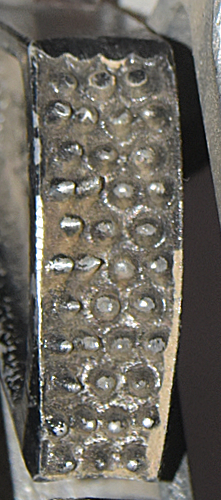 I acquired these ascenders from Cameron Dickinson in 2019.
I acquired these ascenders from Cameron Dickinson in 2019.
This version is 175 mm. tall, 77 mm. wide, 39 mm. thick, and weighs 213 g. The rope channel is 15 mm. wide. The pivot is centered 57 mm. from the inside of the rope channel. The cam radius increases from 41 to 58 mm. over an angle of 39°, giving a 26° cam angle. The teeth are conical and perpendicular to the cam face. The tooth pattern is (4.3)^5.
The Roloff ascender uses a cast aluminum frame, cam, and cam
safety, and are assembled with two machine screws, washers, and
nuts . None of the parts are finished. The frame is patterned
after the old Jumar frame, but the rope attachments have been
changed to one 16 mm. hole below the handle and a second
16 mm. hole above the cam.
The cam is cast aluminum. The cam and cam spring
are mounted on a standard 3/16 inch machine screw secured with a washer
and fluted nut. The screw is center punched so the nut won't accidentally
come off.
The cam safety is cast in the Jumar gray series original pattern.
The safety and safety spring are mounted on a 3/16 inch machine
screw which is threaded directly into the frame.
The serial number "24" is stamped inside the shell of each ascender.
Roloff Ascenders
were developed as an inexpensive alternative to the "expensive"
Jumar, which cost about $15.00 a pair at the
time. They should be viewed as ambitious homemade devices. I find it amazing that anyone would actually attempt to duplicate
a Jumar rather than buy one. A significant
number (about 100-120) appear to have been made; I’d be very interested in knowing
exactly how many.
Roloff ascenders were made in the late 1960s, and by the time Prusiking was published (1973) they were no longer available. Since the
Roloff has been out of production for decades, they are hard to find.
The Jumar is a better
device anyhow, so I don't recommend the Roloff for caving use.
Its value is only as a museum piece, and it belongs in the hands of
a collector.
Like the early Jumars, the Roloff
is very easy to use. The cam can be opened easily with either
hand. I find this Roloff occasionally slips, undoubtedly since
the teeth on it are heavily worn.
The workmanship on this
ascender is not up to commercial standards, but this was not a commercial ascender. The Roloff frame is not as nicely finished as the Jumar.
Thrun quotes some anonymous test results indicating that the Roloff
is weaker than the same vintage Jumar.
I used to think that the lower sling attachment point is superior to the gray series Jumars that the design was based on, but over the years,
my opinion has reversed. My opinion of the upper attachment has is not -
I still prefer the one on the gray Jumars. The Jumar design is easier to grip from above.
The cam is definitely inferior to other eccentric cam ascender
cams. The teeth are very poorly formed, uneven, dull, and wear
quickly. The cam casting and subsequent machining is very crude. These are the only Roloff ascenders in my collection that have painted cams.
In 2009, Carl Kunath gave me a set of original Roloff cams, and Dick Mitchell
gave me a pair of copies that he made by sand casting. The teeth on the copies are more rounded than on the original, as one might expect.
[ Top
| Version A
| Version C
| Version D
| Version E
| Modified Version A
| Modified Version B
| Modified Version C
| Return to H.E.C. Ascenders
]
Version B
(#3547)
Technical Details
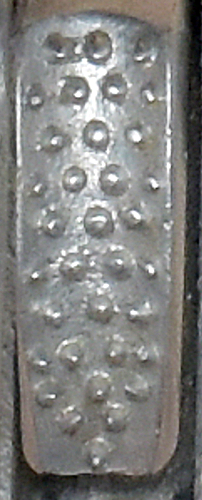 I acquired this Roloff from Gary LeMacs in 2022. It originally belonged to Gari Davis.
I acquired this Roloff from Gary LeMacs in 2022. It originally belonged to Gari Davis.
This version is 176 mm. tall, 77 mm. wide, 36 mm. thick, and weighs 227 g. The rope channel is 14 mm. wide. The cam axle is centered 57 mm. from the inside of the rope channel. The cam radius, measured from the axle axis, increases from 41 to 58 mm. over an angle of 40°, giving a 27° cam angle. The tooth pattern is (3.4)^4(3.2.1).
The serial number "47" is stamped inside the shell of each ascender. Gari stamped his initials "GMD" on the back of each ascender.
The cams on this pair are web cams as opposed to the semi-web cams found on other Roloffs, and the tooth pattern is different as well. Most of the teeth are quite sharp, but the inside of the rope channels in the frame are fairly well worn. This makes me wonder if these are original Roloff cams or later replacements. I suspect the latter, but I currently have no way of being certain.
[ Top
| Version A
| Version B
| Version D
| Version E
| Modified Version A
| Modified Version B
| Modified Version C
| Return to H.E.C. Ascenders
]
Version C
(#167, 2342)
Technical Details
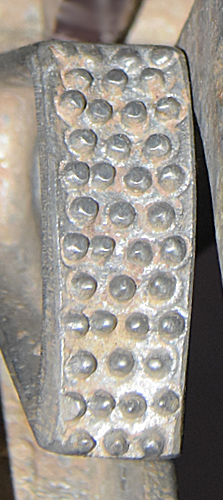 I acquired a left-hand Roloff (serial number 51) from Allen Padgett in 2003. I acquired a pair (serial number 59) from Bill Liebman at the 2017 Old Timers Reunion.
I acquired a left-hand Roloff (serial number 51) from Allen Padgett in 2003. I acquired a pair (serial number 59) from Bill Liebman at the 2017 Old Timers Reunion.
This version is 176 mm. tall, 77 mm. wide, 38 mm. thick, and weighs 217 g. The rope channel is 14 mm. wide. The cam axle is centered 57 mm. from the inside of the rope channel. The cam radius, measured from the axle axis, increases from 42 to 58 mm. over an angle of 39°, giving a 24° cam angle. The tooth pattern is (4.3)^6.
The serial number is stamped inside the frame.
The cam is very loosely mounted
on the cam pivot, and with slight sideways pressure the cam can
hang up on the side of the rope channel. This keeps the cam from
closing, and can ruin your day if it happens at an inopportune
moment.
Bill Liebman got the pair with serial number 59 from Ernie Coffman. Previous owners of that pair included Vance Smith (who stamped these with his initials "VMS") and Donald Bird (who engraved his name and NSS number).
[ Top
| Version A
| Version B
| Version C
| Version E
| Modified Version A
| Modified Version B
| Modified Version C
| Return to H.E.C. Ascenders
]
Version D
(#2305)
Technical Details
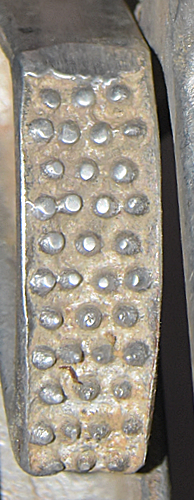 I acquired my Roloff, Version D from Bill Liebman in 2017.
I acquired my Roloff, Version D from Bill Liebman in 2017.
This version is 176 mm. tall, 76 mm. wide, 37 mm. thick, and weighs 209 g. The rope channel is 14 mm. wide. The cam radius increases from 42 to 58 mm. over an angle of 39°, giving a 24° cam angle. The tooth pattern is (4.3)^6.
There are no markings on this pair of ascenders.
They do not have serial numbers, so they are later than Versions A, B, and C. The safety is screw-mounted, making them earlier than Version E. These have original cams that have seen enough use to nearly wear away the top row of teeth, but the remaining teeth are in fairly good condition.
[ Top
| Version A
| Version B
| Version C
| Version D
| Modified Version A
| Modified Version B
| Modified Version C
| Return to H.E.C. Ascenders
]
Version E
(#2040, 2181, 3600, 3601)
Technical Details
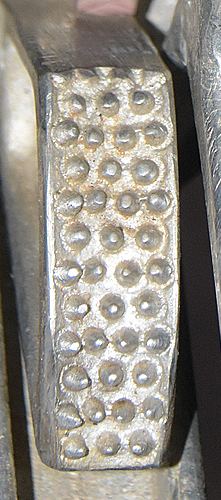 I acquired my Roloff, Version E at the NSS Auction in 2016. I acquired another pair in 2017 as part of Bob Thrun’s collection, and two more pairs from Michael Oatney in 2023.
I acquired my Roloff, Version E at the NSS Auction in 2016. I acquired another pair in 2017 as part of Bob Thrun’s collection, and two more pairs from Michael Oatney in 2023.
This version is 176 mm. tall, 76 mm. wide, 37 mm. thick, and weighs 209 g. The rope channel is 14 mm. wide. The cam axle is centered 57 mm. from the inside of the rope channel. The cam radius, measured from the axle axis, increases from 42 to 58 mm. over an angle of 39°, giving a 24° cam angle. The tooth pattern is (4.3)^6.
The safeties and safety springs on this pair are mounted 3/16 inch (4.8 mm.) pins pressed into the frame and filed smooth on both ends.
There are no markings on this pair of ascenders.
After many years, I finally was able to obtain a good set of unmodified original Roloff ascenders at the NSS Auction in 2016. After my purchase, the original owner (whose name I failed to record) told me that these were made in 1968 or 1969. He believed that they were the last pair made, since they were specially assembled for him from the last remaining parts.
[ Top
| Version A
| Version B
| Version C
| Version D
| Version E
| Modified Version B
| Modified Version C
| Return to H.E.C. Ascenders
]
Modified, Version A
(#48)
Technical Details
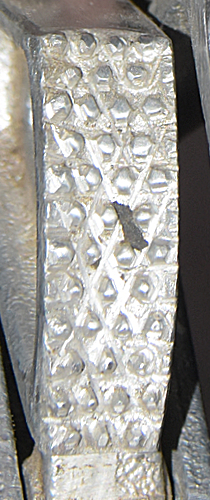 I acquired this pair of ascenders (serial number 17) from Darrel Tomer in 1985.
I acquired this pair of ascenders (serial number 17) from Darrel Tomer in 1985.
This pair is heavily modified. In the current condition, each is 175 mm. tall, 77 mm. wide, 39 mm. thick, and weighs 208 g. The rope channel is 15 mm. wide. The cam radius increases from 41 to 58 mm. over an angle of 39°, giving a 26° cam angle. The tooth pattern is (4.3)^5.
The holes in the rope channel
and the handle portion of the frame seen in the photographs are
later additions due to Darrel’s tinkering, as is the steel sheet
metal wear plate added inside the channel. One of the cam springs
is very strong, the second is very weak. The former is
original and the latter is a replacement. The cam and cam spring
are mounted on a standard 3/16 inch machine screw with a washer
and fluted nut. The screw is center punched so the nut won't accidentally
come off. The cam teeth are hand filed in a (4.3)^5 pattern. The safety and safety spring are mounted on a 3/16 inch machine
screw which was originally threaded directly into the frame. The
threads are stripped out on the left hand ascender, so a longer
screw and hex nut have been substituted.
The serial number "17" is stamped inside the shell of each ascender.
Darrel Tomer loved to modify equipment, and his two Roloff
ascenders were recipients of substantial modification. When I first saw these in 1978, they had PVC pipes bolted to them to make long extension handles, and the cams had been replaced by cams from the original gray Jumars. Fortunately,
Darrel saved all the parts he removed, so I was able to restore them
to something resembling their original condition.
This Roloff ascender has hand
filed cam teeth. I once thought that Darrel made a replacement cam, but I now believe that he merely sharpened the original cam teeth once they started to wear. Making replacement cams was not unheard of.
See Johnston, J. and D. Myrick, Homemade Ascender Cams, The
Huntsville Grotto Newsletter, v. IX, # 6, June-July 1968, pp.
81-85 (reprinted in the 1968 Speleo Digest, pp. 3-76 - 3-79) for one way to do this.
[ Top
| Version A
| Version B
| Version C
| Version D
| Version E
| Modified Version A
| Modified Version C
| Return to H.E.C. Ascenders
]
Modified, Version B
(#2179)
Technical Details
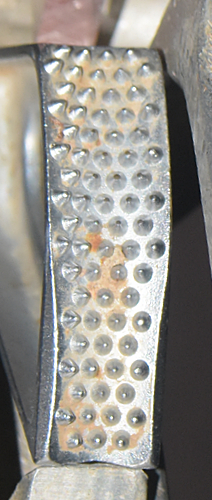 I acquired this pair of ascenders (serial number 50) in 2017 as part of Bob Thrun’s collection. He bought these from Louise Hose at an NSS auction.
I acquired this pair of ascenders (serial number 50) in 2017 as part of Bob Thrun’s collection. He bought these from Louise Hose at an NSS auction.
This pair is modified. In the current condition, each is 176 mm. tall, 77 mm. wide, 38 mm. thick, and weighs 253 g. The rope channel is 14 mm. wide.
The original ascender cams were replaced by early Jumar cams. The cam radius increases from 42 to 60 mm. over an angle of 41°, giving a 27° cam angle. The tooth pattern is (4.5)^5(4.3)^4.
The serial number "50" is stamped inside the frame.
The Roloff cams were made of aluminum. These wore quickly, and so a popular modification was to replace the worn cams with early Jumar cams made from stainless steel. These were readily available before tort liability lawyers ruined the world.
[ Top
| Version A
| Version B
| Version C
| Version D
| Version E
| Modified Version A
| Modified Version B
| Return to H.E.C. Ascenders
]
Modified, Version C
(#2192)
Technical Details
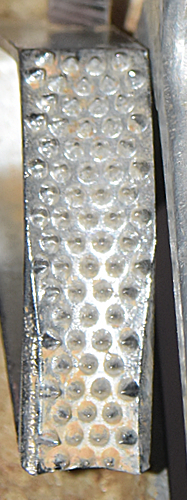 I acquired this pair of ascenders from Rich Banning at the 2019 NSS Convention.
I acquired this pair of ascenders from Rich Banning at the 2019 NSS Convention.
This pair is modified. In the current condition, each is 176 mm. tall, 77 mm. wide, 38 mm. thick, and weighs 255 g. The rope channel is 14 mm. wide.
The original ascender cams were replaced by early Jumar cams. The cam radius increases from 42 to 60 mm. over an angle of 41°, giving a 27° cam angle. The tooth pattern is (4.5)^5(4.3)^4.
Rick stamped "BANNING" inside the frame of each ascender.
These are later Roloffs as indicated by the lack of serial numbers inside the frame and the pin (not screw) holding the safety.
Rick attached notes to each ascender. The one on the right ascender read as follows:
"Roloff Ascender - Right 1 May 19
bought via ad in NSS News, 1960s
I replaced the Roloff cams as I thought they weren't well made + might wear too fast.
Rick Banning
The note on the left ascender read as follows:
Roloff Ascenders - Left 1 May 19
One good thing about Roloffs vs. Jumars -
Roloff made it easy to replace the cam - just undo the cam bolt; no rivet Plus a ’biner hole top and bottom.
Rick Banning
The Roloff cams were made of aluminum. These wore quickly, and replacing the cams with early Jumar stainless steel cams was a popular option.
I do not recommend attaching slings to Roloff ascenders with carabiners; instead, I prefer to tie my slings directly to the ascenders.
[ Top
| Version A
| Version B
| Version C
| Version D
| Version E
| Modified Version A
| Modified Version B
| Modified Version C
]


